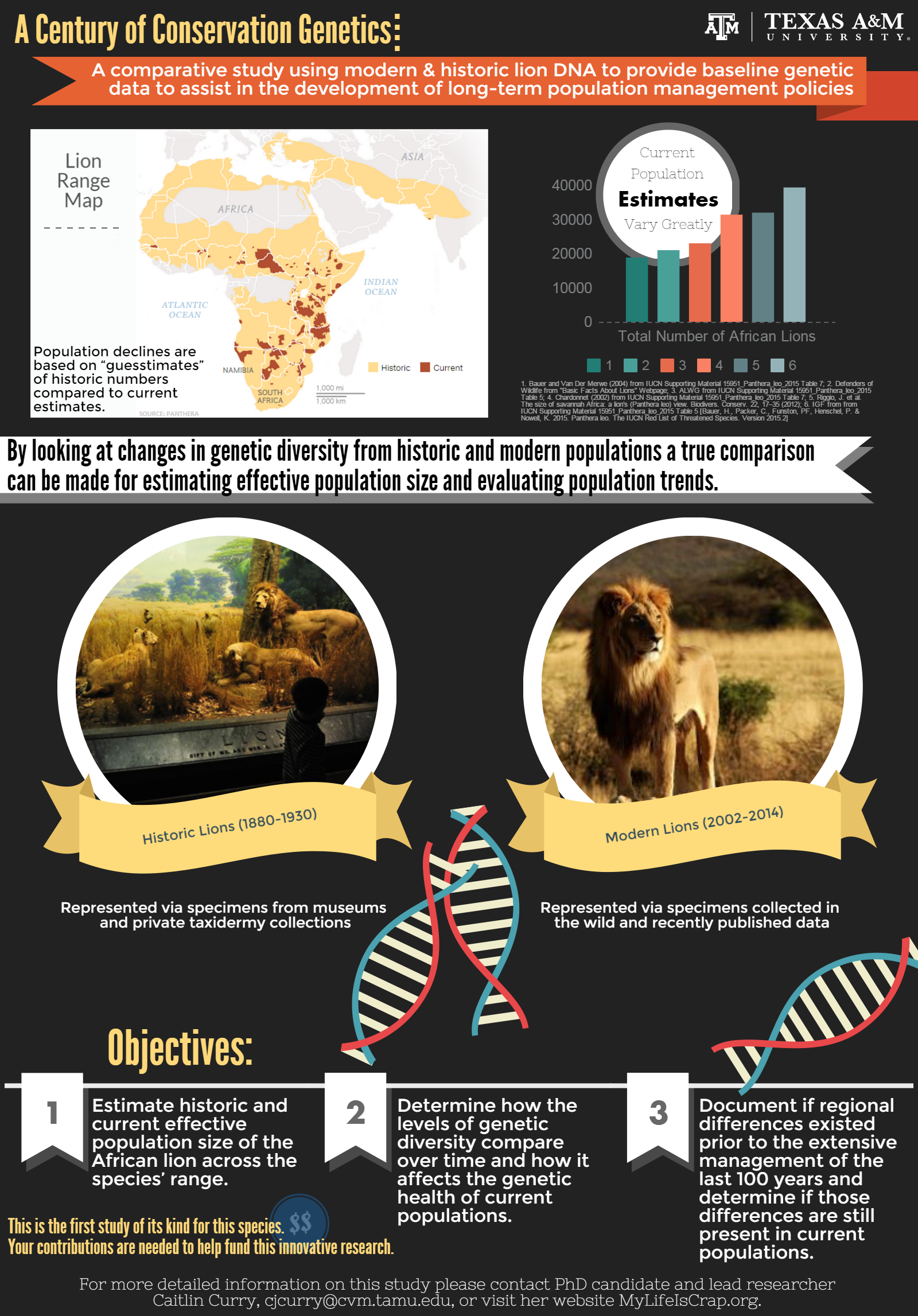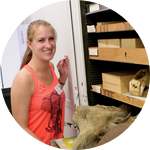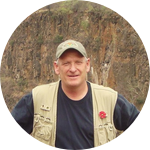Project Results
Mitochondrial Haplotype Diversity in Zambian Lions: Bridging a Gap in the Biogeography of an Iconic Species
Caitlin J. Curry, Paula A. White, James N. Derr
About This Project
In this study, we will compare genetic information from 100-year-old lions preserved in museums to modern lions. The goals are to estimate the historical population size of African lions across the species range, compare levels of genetic diversity of lions overtime to provide a baseline for determining the genetic health of current populations, and document regional differences in genetic diversity in populations that lived before extensive management efforts of the last 100 years.
Ask the Scientists
Join The DiscussionWhat is the context of this research?
Because genetic diversity is directly related to a species' ability to adapt survive and thrive within its environment, loss in diversity can be detrimental to the health of the population as a whole. As genetic diversity drops the chances of long term survival of the species can drop too. We don't know enough about the genetic history within the wild lion population to know how recent changes to the African landscape that has resulted in a reduction of the lions’ home range has impacted the genetic health of the lion population. Luckily, we have the specimens and technology to answer this question.
What is the significance of this project?
The African Lion is iconic, not only representing Africa, but all things wild. But, research and conservation efforts for the African lion are limited. Scientific estimates of lion population sizes range from as low as 16,000 to as high as 200,000 individuals estimated using very different methods during different time periods. More reliable information is needed to make accurate conservation decisions. This project looks at the changes in genetic diversity from historic and modern lion populations so that a true comparison can be made for estimating population size and evaluating population trends. With the data we can identify existing wild lion populations that are most at risk and make recommendations to guide management actions.
What are the goals of the project?
There are hundreds of lions preserved in natural history museums worldwide. I already have samples from over 90 lions who lived between 1895-1930 and would like to, at least, double the number of samples in our collection. With these samples, I will estimate historical population size of African lions across the species' range. With access to data and/or DNA from over 1000 lions from across present day Africa, I will also directly compare levels of genetic diversity from lions over time to provide a baseline for determining the genetic health of current lion populations. Lastly, this project will document regional differences in genetic diversity that existed in African lion populations prior to the management efforts of the last 100 years.
Budget
$400 = General laboratory supplies for DNA extraction and sequencing including pipet tips, test tubes, 96-well plates, etc.
$600 = KAPA2G Robust HotStart PCR Kits (2)
• Sequencing & Genotyping – $2,000
$1,000 = Fluorescent Labeled/Unlabeled Primer Pairs for PCR
$1,000 = Reagants (ExoSAP-IT, BigDye Terminator, SAM Solution, etc.) and genotype & sequence machine maintenance
• Travel – $2,000+
This support is for travel to museums to collect historical lion samples. Exact source locations will depend upon responses of curators to pending inquiries, with a priority given to those museums housing the largest number of lion specimens meeting the search criteria. A full list of museums we are interested in visiting can be found here. This estimate is based on economy airfare and standard per diem rates used by Texas A&M University.
Caitlin is the lead researcher for this project and is supported through Texas A&M University as a Teaching and Reasearch Assistant.
Meet the Team
Caitlin Curry
I have a doctorate in population & conservation genetics from the interdisciplinary program of Genetics at Texas A&M University. My dissertation was research on biodiversity of the African lion. At Texas A&M, I took on leadership roles and strove to be an active member of the academic committee regularly attending program & departmental seminar series. I have done both oral and poster presentations at national, local and University-level conferences and symposia. I have received multiple awards through the University and College of Veterinary Medicine, such as being a recipient of the Graduate Student Research Trainee Grant. I am a participating member of multiple graduate student organizations. I have been an officer for the Genetics Graduate Student Associate as a website committee member, the head of recruitment, and Vice-President.
I have a Bachelor of Science from the University of Washington (2006) in Psychology with a focus in Animal Behavior and Cognitive Neuroscience and a minor in Anthropology. After graduating, I traveled to the Amazon (2006), visited the Wildlife Conservation Research Unit at the University of Oxford in England (2007), became a certified dog trainer through the Animal Behavior College (2007-2008), and obtained an equivalent to a bachelor’s in biology from taking courses at various universities in Southern California (2009-2011).
In addition to travel and education, I was a volunteer researcher for over five years (2007-2012) for the San Diego Zoo’s Institute for Conservation Research participating in studies on various species of bears, birds, elephants, and local fauna. I was the zoo’s primary research assistant for two studies on the giant panda implemented in association with Mississippi State University. I have also been working with the Cheetah Conservation Fund since 2005 through research, outreach and fundraising.
James Derr
My lab consists of the DNA Technologies Core Laboratory and the Texas A&M African Wildlife Conservation Genomics program. The lab uses biotechnology for the conservation and restoration of biodiversity of various species. Over the past two decades, the lab has focused primarily on North American wildlife and domestic livestock, featuring the American Bison. Merging my passion for African wildlife with my profession, I have set a goal to bring conservation genetic technologies to African species spanning sub-Saharan Africa. I have been to Africa more than 20 times including taking Texas A&M students on an African Wildlife Conservation and Health Study Abroad Course each year for the past 4 years.
Additional Information

Project Backers
- 87Backers
- 102%Funded
- $5,127Total Donations
- $58.26Average Donation

